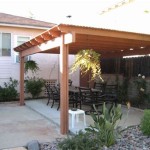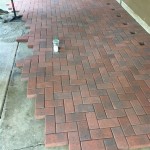How to Seal an Outdoor Concrete Patio
An outdoor concrete patio, exposed to the elements, requires regular maintenance to ensure its longevity and aesthetic appeal. Sealing concrete provides a protective barrier against moisture, stains, and damage caused by freeze-thaw cycles. This article outlines a comprehensive guide on how to effectively seal an outdoor concrete patio, including preparation, choosing the right sealant, and application techniques.
Preparing the Concrete Surface
Proper preparation is paramount to a successful sealant application. A clean and properly prepared surface ensures optimal sealant adhesion and performance. Failing to adequately prepare the concrete can lead to sealant failure, resulting in peeling, bubbling, or discoloration. The preparation process involves several key steps, each contributing to the overall success of the sealing project.
Cleaning the Concrete: The initial step involves thoroughly cleaning the concrete surface. This process aims to remove all dirt, debris, oil, grease, mildew, and existing coatings. A pressure washer is highly recommended for this task. Applying a concrete cleaner or degreaser before pressure washing can further enhance the cleaning process, especially for surfaces with stubborn stains or grease buildup. Allow the cleaning solution to dwell on the surface for the recommended time, as indicated on the product label, before rinsing thoroughly with the pressure washer. Pay particular attention to areas with heavy soiling or staining, ensuring all contaminants are removed.
Repairing Cracks and Damage: Inspect the concrete surface for any cracks, chips, or other forms of damage. These imperfections need to be addressed before applying the sealant. Small cracks can be filled with a concrete crack filler specifically designed for outdoor use. Follow the manufacturer's instructions for application, ensuring the filler is properly compacted into the crack. For larger cracks or significant damage, a concrete patching compound may be necessary. Ensure the patching compound is compatible with the existing concrete and the chosen sealant. Allow the crack filler or patching compound to cure completely before proceeding to the next step. This may involve several days, depending on the product and environmental conditions.
Etching the Concrete (Optional but Recommended): Etching the concrete surface creates a slightly porous texture, which improves sealant adhesion. While not always necessary, etching is strongly recommended for dense or smooth concrete surfaces. Concrete etching can be achieved using muriatic acid or a commercially available concrete etching solution. Follow the manufacturer's instructions carefully, wearing appropriate safety gear, including gloves, eye protection, and respiratory protection. After etching, thoroughly rinse the concrete surface to remove all traces of the etching solution. Neutralizing the etching solution with a solution of baking soda and water is also recommended before the final rinse.
Drying the Concrete: The concrete surface must be completely dry before applying the sealant. Moisture trapped beneath the sealant can lead to adhesion problems and premature failure. Allow the concrete to dry for at least 24-48 hours, depending on the weather conditions. Use a moisture meter to verify the moisture content is within the sealant manufacturer's recommended range, typically below 4%. Avoid applying sealant on days when rain is expected or when the humidity is high.
Selecting the Appropriate Concrete Sealant
Choosing the right sealant is crucial for achieving the desired results. Several types of concrete sealants are available, each with its own advantages and disadvantages. Factors to consider when selecting a sealant include the type of concrete, the intended use of the patio, the desired aesthetic appearance, and the local climate. Understanding the properties of different sealant types will enable an informed decision that meets the specific needs of the project.
Acrylic Sealants: Acrylic sealants are a popular choice for outdoor concrete patios due to their affordability and ease of application. They provide a decent level of protection against water penetration and staining. Acrylic sealants are typically water-based and offer good UV resistance. However, they may not be as durable as other sealant types, especially in areas with heavy foot traffic or harsh weather conditions. Acrylic sealants are generally recommended for lightly used patios in moderate climates.
Silicone Sealants: Silicone sealants offer excellent water resistance and flexibility, making them a good choice for areas prone to movement or cracking. They also provide good protection against staining and are relatively easy to apply. However, silicone sealants are not as breathable as other sealant types, which can lead to moisture entrapment if the concrete is not completely dry. They may also be more susceptible to dirt pickup and discoloration over time. Silicone sealants are often used in conjunction with other sealant types to address specific areas, such as joints or cracks.
Epoxy Sealants: Epoxy sealants are known for their exceptional durability and resistance to chemicals, abrasion, and impact. They provide a hard, glossy finish that can enhance the appearance of the concrete. Epoxy sealants are typically two-part systems that require careful mixing and application. They are more expensive than acrylic or silicone sealants and may require professional application. Epoxy sealants are well-suited for high-traffic patios or areas exposed to harsh chemicals or solvents.
Penetrating Sealants (Silanes and Siloxanes): Penetrating sealants, such as silanes and siloxanes, work by penetrating the concrete surface and creating a hydrophobic barrier that repels water. They do not form a film on the surface, which means they do not alter the appearance of the concrete and are breathable. Penetrating sealants provide excellent protection against freeze-thaw damage and are relatively easy to apply. They are a good choice for patios where a natural look is desired and protection against water damage is the primary concern. However, they may not provide as much protection against staining as film-forming sealants.
Polyurethane Sealants: Polyurethane sealants offer a good balance of durability, flexibility, and chemical resistance. They provide a tough, abrasion-resistant finish that can withstand heavy foot traffic and harsh weather conditions. Polyurethane sealants are available in both water-based and solvent-based formulations. Solvent-based polyurethane sealants are generally more durable but may have stronger odors and require more careful application. Polyurethane sealants are a versatile option suitable for a wide range of outdoor concrete patios.
Applying the Concrete Sealant
Proper application is essential for achieving the desired performance and longevity of the sealant. Following the manufacturer's instructions carefully and using the appropriate application techniques will ensure a uniform and durable coating. Factors to consider during application include weather conditions, application method, and the number of coats required.
Weather Conditions: Avoid applying sealant on days when rain is expected, or when the temperature is too hot or too cold. Ideal application temperatures typically range from 50°F to 85°F (10°C to 29°C). High humidity can also affect sealant drying time and adhesion. Check the manufacturer's recommendations for specific temperature and humidity guidelines.
Application Methods: Concrete sealants can be applied using a variety of methods, including rollers, brushes, and sprayers. The choice of application method depends on the type of sealant, the size of the patio, and personal preference. Rollers are a good choice for applying thin, even coats of sealant. Brushes are useful for edging and detail work. Sprayers can be used to apply sealant quickly and efficiently, especially on large patios. Ensure the sprayer is compatible with the sealant being used and follow the manufacturer's instructions for sprayer settings and application techniques.
Number of Coats: Most concrete sealants require two coats for optimal protection. Apply the first coat thinly and evenly, following the manufacturer's instructions. Allow the first coat to dry completely before applying the second coat. The drying time will vary depending on the type of sealant and the weather conditions. The second coat should be applied perpendicular to the first coat to ensure complete coverage. Avoid applying too much sealant, as this can lead to bubbling or peeling.
Curing Time: Allow the sealant to cure completely before exposing the patio to foot traffic or furniture. The curing time will vary depending on the type of sealant and the weather conditions. Refer to the manufacturer's instructions for specific curing time recommendations. Avoid placing heavy objects on the patio during the curing process. Protecting the sealed patio from rain or other moisture during the curing period is also important for optimal performance.
Safety Precautions: Concrete sealants can contain volatile organic compounds (VOCs) that can be harmful if inhaled or ingested. Always work in a well-ventilated area and wear appropriate safety gear, including gloves, eye protection, and respiratory protection. Follow the manufacturer's safety instructions carefully. Avoid contact with skin and eyes. If contact occurs, rinse immediately with plenty of water. Keep sealant containers tightly closed when not in use and store them in a cool, dry place away from heat and flames.

Why You Should Seal Your Concrete Driveway Or Patio Gleam Team

Penetrating Vs Surface Concrete Sealers Which Is Best

7 Steps To Sealing Concrete Like A Pro Expert How Guide Network

Concrete Patio Sealer Gatorguard

How To Clean Seal Your Concrete Patio

How To Seal A Concrete Patio Once U C Coatings

How To Seal Concrete Effectively Lowe S

How To Easily Tile Over An Existing Concrete Patio

How To Stain Concrete Simple Diy Method

Resurfacing A Concrete Patio For Budget Diy Makeover Fab Everyday
Related Posts








